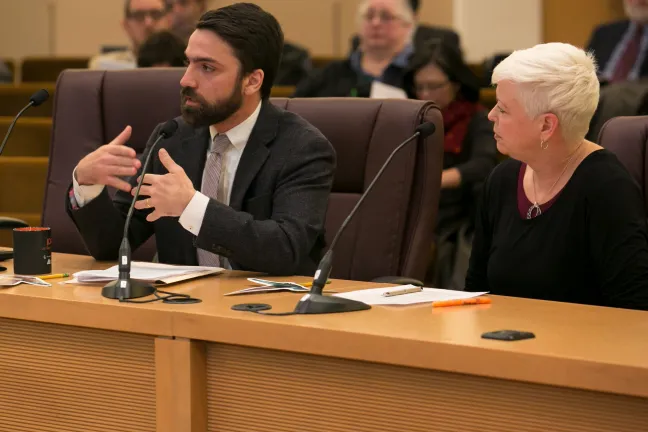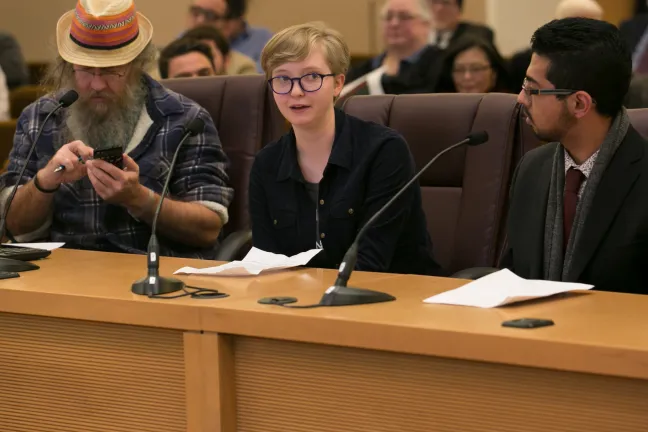The Multnomah County Board of Commissioners voted Thursday to formally share feedback on the Oregon Department of Environmental Quality’s Cleaner Air Oregon (CAO) draft air-quality rules.
The board, which also serves as the county’s Local Public Health Authority, authorized the county’s Office of Sustainability to submit written comments on the state’s proposed rules. The draft plan is meant to regulate industrial air toxics and reduce the effects pollutants have on the health of Oregonians.
The state’s draft rules are a step in the right direction, stressed Chair Deborah Kafoury and other commissioners. But they also said the rules don’t go far enough to close loopholes and give the Department of Environmental Quality too much discretion when protecting the most vulnerable Oregonians.
“Our air is a resource that we all share, and it’s our job to ensure that these kinds of fundamental resources are protected,” Kafoury said. “Children, older adults and people with pre-existing conditions are particularly at risk from air toxins, and that’s why having strong rules that prioritize public health and prioritize the health of our most vulnerable members is so important.
“We want DEQ to ensure that this program is a model for the protection of environmental justice communities,” she continued. “We want to make sure that the loopholes in the current draft of the rules are eliminated and that communities have greater certainty that their air will be protected.”
John Wasiutynski, director of the Office of Sustainability, walked the board through the past eight years of environmental studies and policy development in the region and state. The state implemented the federal minimum program, requiring the installation certain types of technology to control pollution.
But in early 2016, air quality data that showed pollution hotspots in Multnomah County raised questions in the community about the effectiveness of Oregon’s current regulations.
“As we learned with the events of February 2016, when ambient air quality monitoring showed high levels of certain types of dangerous metals in Southeast Portland, those types of federal minimum programs aren’t sufficient enough to protect Oregonians from industrial hotspots,” said Wasiutynski.
The county and its partners convened several well-attended public hearings on the issue last year, and a concerted community push for stronger health-based standards emerged.
“We’re echoing those voices today in saying we want health based-standards,” Wasiutynski said.
Also in 2016, Governor Kate Brown launched Clean Air Oregon, which directed DEQ and the Oregon Health Authority to overhaul industrial permitting rules.
The pursuit of those changes “moves away from succumbing to the false dichotomy that economic prosperity and public health are somehow in opposition to one another,” said Dr. Jae Douglas, director of environmental health services in Multnomah County.
But Douglas said the state environmental department has not yet specifically and explicitly outlined the rules’ environmental justice impacts, something required under state and federal law.
Among the recommendations
- Explicitly outline the agency’s statutory obligations under federal and state law (including Title VI of the Civil Rights Act of 1964, Executive Order 12898, and ORS 182.545) to account for the environmental justice impacts of the proposed rules. The Oregon Environmental Justice Task Force specifically requested that DEQ clearly state its legal obligation to ensure that the program does not disproportionately impact communities of color and low-income communities.
- Meet the spirit of its statutory obligation pursuant to ORS 182.545 to fully staff and resource a Citizen Advocate position to ensure that underrepresented and disproportionately impacted communities have opportunities to meaningfully participate in critical permit and rulemaking processes that will affect their health and lives
- Targeted community engagement in the Multi-Source Risk Area determination process
- Revise pollution risk action levels (RAL) for permitted industries from dangerously high levels to values more consistent with the purpose of the program.
- Read more on the full recommendations
Volunteers with Neighbors for Clean Air and other advocates commended the board’s feedback.
“I’ve lived on the bluff near the University of Portland my entire life, so the smells wafting up at us from the Swan Island factories have been a regular feature of my families neighborhood walks,” said Fiona McClary, a junior at St. Mary’s Academy. “Like many in Portland, I’ve dealt with lung problems for several years. I’m glad to see a program that acknowledges the problem at all, but I would like to see it improved to address where it falls short in health and environmental justice.”
“Our government’s decision will impact us young people for many decades to come. Laws and regulations can be revised overturned and replaced but never truly erased - even if it is improved the effects of this program are forever.”



